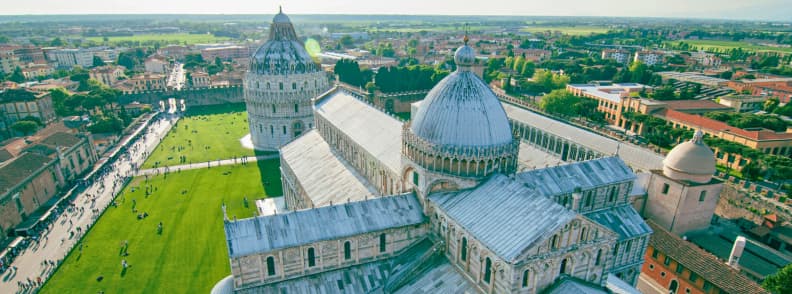Planning to visit Pisa? Most people think of it as a one-photo stop where you lean, snap, and leave. I’ve been there twice: once by car from Florence with my family, once by bus from a sailboat moored on the River Arno, near Marina di Pisa. Same city, different angles. What I found is that Pisa has more going on than people give it credit for. It’s walkable, quietly beautiful, and surprisingly layered if you take your time.
This guide brings together everything you need to plan your own trip, from the best things to do in Pisa (yes, including the Leaning Tower and what’s actually worth paying for), to where to eat, how to get there, when to go, how much it costs, and what else not to miss. You’ll get Pisa travel tips for budget travelers, ideas for day trips from Pisa, where to stay, and practical help if you’re traveling to Pisa with kids, as a couple, or even coming in by sailboat.
Visit Pisa Travel Guide
I’ll also give you honest takes: what I skipped (and why), what surprised me, what wasn’t worth it. This Pisa travel blog is based on real trips, grounded in practical advice, and packed with insider tips to help you see Pisa for what it really is: a small Tuscan city worth slowing down for.
Disclosure: Some of the links below are affiliate links. This means that at no extra cost to you, The Travel Bunny will earn a small commission if you click through and make a purchase. Thank you!
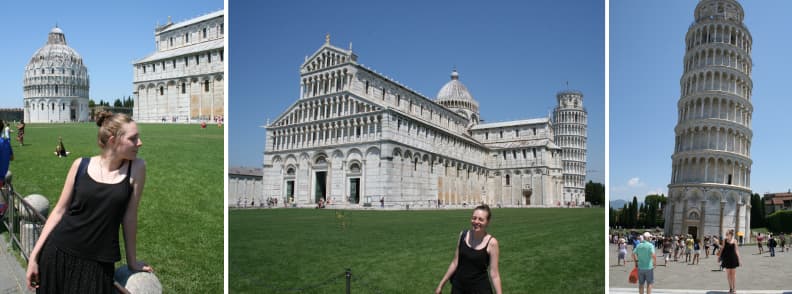
Why Visit Pisa? Is Pisa Worth Visiting?
It’s easy to write Pisa off. Is Pisa worth visiting for a day? Most people come for the Leaning Tower of Pisa, take the photo, and move on. That’s exactly what I expected, too, until I actually went. And then returned, on a completely different kind of trip. What I found both times was a city that quietly rewards anyone who gives it more than a glance.
Visit Pisa Beyond Its Leaning Tower
On my first visit, we drove in from Florence, squeezed into a crowded piazza, and dodged selfie sticks. Still, the white marble of the Pisa Cathedral, the striped Tuscan design, the wide lawn, and the perfect geometry of the Piazza dei Miracoli stopped me in my tracks. The second time, I arrived by bus from our sailboat during the 2020 pandemic and saw the same square practically empty. Same tower. Completely different experience.
Beyond its beautiful architecture, Pisa is also a university town, with a young crowd, slightly worn streets, and corners that feel lived-in. Pisa is much more than its Leaning Tower. It’s long walks along the River Arno, a surprising art alley gallery tucked behind the main roads, and afternoons that feel slower than you’d expect from a place so famous.
Local Pisa Tip: If you can time your visit early or off-season, you’ll see why Pisa deserves more credit. I saw Pisa nearly empty once… and that’s when it impressed me the most! The same monuments feel completely different without tour buses parked outside.
Small, Walkable, And Well-Placed
If you’re planning to see Tuscany without rushing, visit Pisa Italy as a base or stopover. The city is flat, compact, and incredibly walkable. You don’t need a car. You don’t need to stress about schedules. You can walk from Pisa train station to the Tower in under 25 minutes, and pass cafés, side alleys, and open-air markets along the way.
And if you’re putting together a bigger itinerary, Pisa is well-connected. It sits between Florence, Lucca, and the coast, with trains that run like clockwork. Pisa day trips from Florence are common, but the reverse is just as easy. When we visited Viareggio from Pisa, we ended the day with a beach swim. On the second trip, we left Pisa and headed south by sea.
Pisa Travel Tip: If you’re traveling with a toddler or baby, Pisa’s flat layout is ideal. You can get around with a stroller without much hassle, and the pedestrian zone around the Tower gives them space to run.
Architecture, Atmosphere, and a Bit of Quiet
What stayed with me most wasn’t the Tower itself, but the sense that Pisa still belongs to its residents. You’ll find student cafés with no English menus, quiet churches with no lines, and spots where local kids ride bikes while tourists focus their cameras on the Tower’s tilt.
If you care about architecture, Pisa will reward you, especially if you love Tuscany-style cathedrals with their striped facades and clean lines. If you’re into photography, the light across the Arno or from the top of Piazza dei Cavalieri is stunning late afternoon. And if you’re chasing a slower Italy, where things unfold at street level, Pisa fits the part.
What to See in Pisa. Top Attractions + Hidden Gems
You already know about the Leaning Tower of Pisa. Everyone does. But that’s not the whole picture. The best way to visit Pisa is to start with the big sights, then wander. That’s what I did both times, and it’s how I found quiet museums, street art, and spots with no one around.
Here’s exactly what to see when you visit Pisa: the top attractions, the free things to do in Pisa, the hidden gems in Pisa, and what’s actually worth your time and money.
Piazza dei Miracoli, Pisa’s Famous Square
This is the centre of it all, and yes, it’s where most people head first. The name means Square of Miracles, and you’ll understand why as soon as you step onto the green lawn. The buildings are white, massive, and completely out of proportion with the calmness of the city around them.
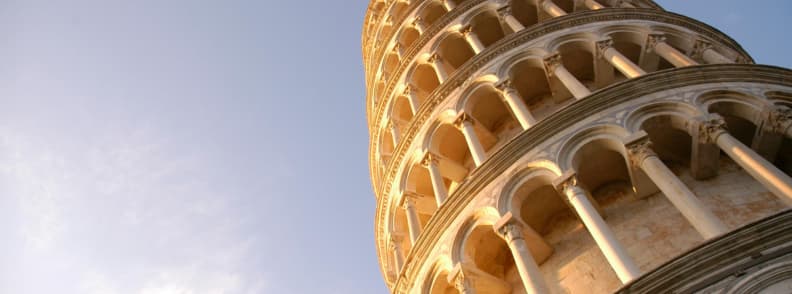
Leaning Tower of Pisa
The most famous sight in the city is the Leaning Tower of Pisa, and it draws a crowd from the moment the gates open. Everyone flocks to it. Everyone takes the photo. It’s impressive in person, and the tilt is more dramatic than you expect. But if you’ve seen it once, that might be enough. I’ve been to Pisa twice and never done the Pisa Tower climb. Not once did I feel I’d missed something.
The Leaning Tower of Pisa is 56 metres tall, and yes, the view stretches over the rooftops and the River Arno Pisa, but it’s not a perspective you can’t get elsewhere in Tuscany. The climb itself is steep and tight, with 294 steps and no elevator. It’s also not accessible to children under 8, which makes it a no-go for many families.
You’ll need to book Leaning Tower of Pisa tickets in advance. Entry is controlled by timed slots, with groups going up every 15 to 20 minutes. That sounds flexible, but the tickets sell out quickly in high season, and your slot is strict. Climbing the Leaning Tower of Pisa tickets cost €20 for the Tower alone or €27 if you also want access to the Cathedral, Baptistery, and Camposanto. Honestly, I’ve always felt that money is better spent elsewhere. That’s unless climbing is something you’ve wanted to do for years and it’s on your personal list.
I’ve skipped the Pisa tower climb not just because of the queues or the entry fee. For me, the tower is more powerful viewed from the square, especially when the light is soft and the crowds are thin. The exterior’s curve, the white stone, the strange tilt… that’s where the magic is. And Pisa isn’t the only place in Italy with a leaning tower. Bologna has two. Venice has one. The novelty isn’t exclusive.
If you do want to go up, buy your Leaning Tower Pisa tickets early, online, and choose your time well. The skip the line Pisa promise only holds if you’re already holding a valid slot. Midday is the worst time. It’s hot, harsh light, and packed with group tours. Early morning or late afternoon gives you better conditions, more space, and stronger photos.
Visit Pisa Leaning Tower Tip: You’ll get the best Tower photos from behind the Camposanto, facing east in the morning or west around golden hour. The Tower leans more noticeably from that angle, and it’s where I took my favourite shot.
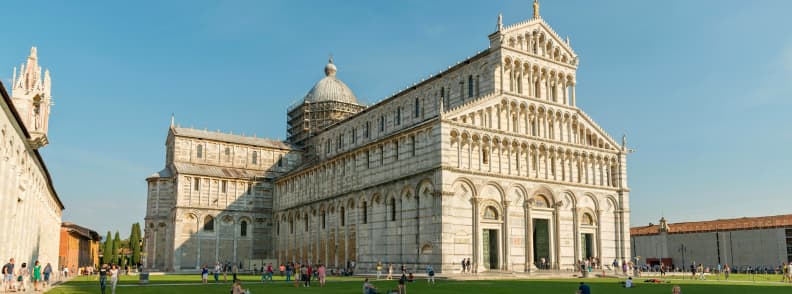
Pisa Cathedral or Duomo di Pisa
Inside the square, the Pisa Cathedral is the building that held me longest. Not the Tower. Not the museum. This is where I stayed, walked slowly, and looked up. I’ve always loved striped Tuscan churches, and the Duomo di Pisa is one of the finest I’ve seen. Its bold façade, layered in black-and-white Carrara marble, catches the light in a way photos can’t quite capture. And the scale of it (bigger than any of the other buildings in the square) often goes unnoticed by people rushing straight to the Tower of Pisa.
Built in 1064, the Pisa Cathedral shows off the full blend of Romanesque and Arabic influences that define the region’s architecture. The design is unmistakably local: rounded arches, bronze doors, and a deep rhythm to the façade that anchors the entire Piazza dei Miracoli.
Step inside and the atmosphere shifts. You go from tourist chaos to something quiet, golden, and almost solemn. The nave leads you under a coffered ceiling with gold detailing, and just above the apse, a striking gold mosaic of Christ dominates the space. The marble pulpit by Giovanni Pisano, carved with biblical scenes and supported by lions, is a masterpiece worth pausing for.
What surprised me most was how peaceful it felt, especially early in the morning. I came before the tour groups arrived and found myself almost alone beneath those high, reflective ceilings. Compared to the buzz around the Tower, this space actually lets you breathe.
You can enter for free, but a timed ticket is required. That sounds like a formality, but it helps keep the flow manageable. You can book it in person or online and I’d recommend doing it ahead if you’re visiting in high season. The Duomo di Pisa is open daily from 10:00 to 20:00, though hours shift slightly in winter.
Pisa Trip Tip: If you’re only picking one monument to enter (whether because of time or budget), make it this one. The Pisa Cathedral has more depth, beauty, and meaning than the Tower of Pisa, and the experience lingers longer.
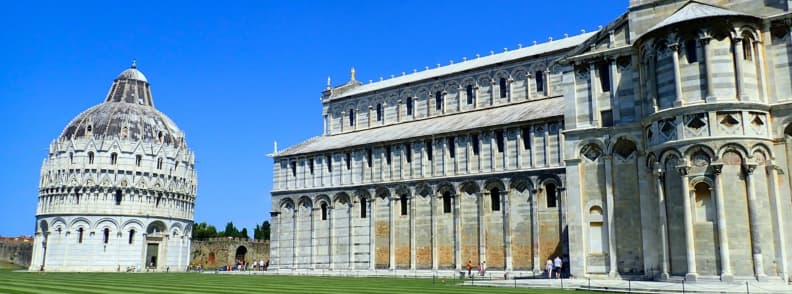
Pisa Baptistery or Battistero di San Giovanni
Right beside the Cathedral stands the Pisa Baptistery, and it’s worth stepping inside. Not for the decoration, but for the sound. This is the tallest baptistery in Italy, at 54 metres tall, and it looks like something out of a fantasy sketch: rounded like a beehive, layered in Romanesque stonework and topped with a Gothic dome that feels a bit too big for its base. From the outside, it’s one of the most recognisable shapes in the Piazza dei Miracoli.
But what makes the Battistero di San Giovanni unforgettable is the acoustics. Inside, when the space isn’t too crowded, a staff member steps into the centre and sings. Just a few clear notes, spaced apart, and the sound swirls through the dome above you. A single note can echo for over 10 seconds. I’ve never heard anything like it inside a church. The effect is haunting, especially if you’re standing quietly. If you’re lucky enough to be there during a demonstration, don’t speak. Just listen.
Built between 1152 and 1363, the Pisa Baptistery starts Romanesque and ends Gothic. It’s a rare architectural mix that’s easy to miss if you’re not looking up. Inside, it’s simpler than the Cathedral, with a central octagonal font and layered galleries circling the upper level. You won’t find ornate frescoes or gilded ceilings here, but if you enjoy early medieval architecture, there’s a calm presence to it. It’s less emotionally moving than the Duomo, but still powerful in its restraint.
Most people miss the structure’s history. This baptistery was once the spiritual gateway to the Cathedral. After being baptised here, you were ready to enter the church. And like everything else in this square, the design goes beyond beauty and carries meaning.
Get the Pisa all inclusive ticket that includes a guided tour through Piazza dei Miracoli, and access to the Leaning Tower, Pisa Cathedral, Pisa Baptistery, Camposanto, Museo delle Sinopie, and Museo dell’Opera del Duomo.
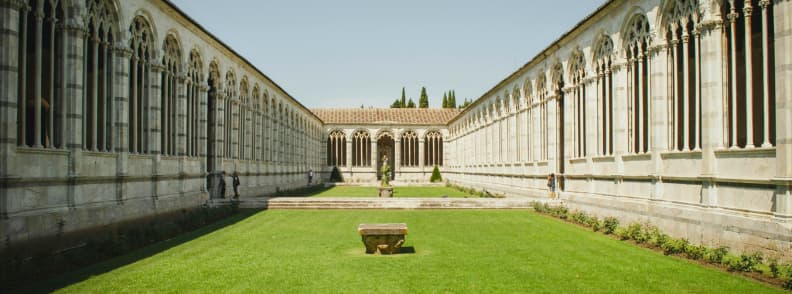
Camposanto Monumentale
The third monument in the Piazza dei Miracoli is the Camposanto Monumentale, which means Monumental Cemetery. It sits just to the north of the Cathedral, quiet and walled off, and most people walk past it without looking twice. But inside is one of the most unexpected spaces in the whole city. It’s not a cemetery in the typical sense, but a long, light-filled cloister lined with history, silence, and stone. It feels more like a hidden museum than a burial ground.
The Camposanto Monumentale was started in 1277 and finished nearly two centuries later. Legend says it was built over sacred soil brought back from Calvary during the Crusades. You don’t have to believe the story to feel the gravity of the place. It’s not religious in a formal way; it’s reflective. The long arcade is open to the sky, the air is still, and the walls are covered in layers of frescoes, some shattered by WWII bombings and carefully restored in recent decades. The damaged parts speak just as loudly as the preserved ones.
Camposanto Monumentale was where Pisa’s nobility wanted to be buried. You’ll see Roman sarcophagi, medieval tombs, and more modern plaques all coexisting without hierarchy. You can walk, pause, sit, and take it in without being jostled by crowds. It’s a place that gives you time.
Pisa Vacation Tip: If you’re choosing between sites and want something that most visitors miss, pick the Camposanto Monumentale. It’s the quietest part of the Piazza dei Miracoli, and it stays with you far longer than the Tower of Pisa does. If you need a quiet place to walk, reflect, or sit in the shade, this is one of Pisa’s most overlooked treasures.
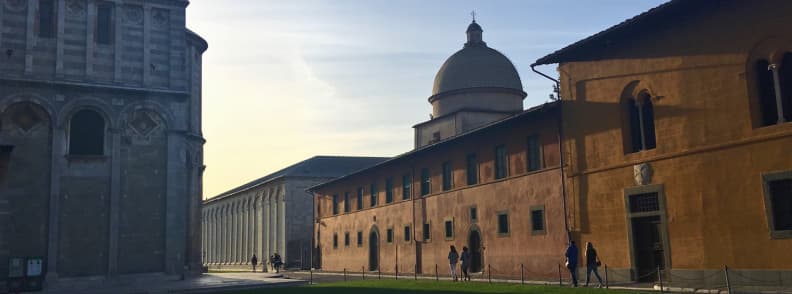
Museo dell’Opera del Duomo & Museo delle Sinopie
If the square feels too hot or too crowded, the Museo dell’Opera del Duomo and the Museo delle Sinopie are the best places to step out of the flow. They’re small, quiet, and fully air-conditioned, and most visitors don’t even realise they exist. Both are part of the same complex and included in the Pisa all inclusive ticket that also covers the Pisa Baptistery and Camposanto Monumentale.
The Museo dell’Opera del Duomo holds original sculptures and relics removed from the Pisa Cathedral and the Pisa Baptistery for protection. You’ll see the original pulpit by Giovanni Pisano, works in bronze and marble, and a striking collection of religious art from the 11th to the 15th century. What I liked most were the facade details. Up close, you notice carving work that’s almost impossible to see properly when they’re mounted high above the Cathedral doors. It’s a way to slow down and truly absorb the craftsmanship that built the monuments outside.
Next door, the Museo delle Sinopie tells a different story. After WWII bombings damaged the Camposanto Monumentale, these pre-fresco drawings were uncovered under the ruined paintwork. Called sinopie, they’re the original charcoal sketches that guided the painters. On their own, they look ghostly and sparse, but knowing they were nearly lost gives them weight. If you like the behind-the-scenes side of religious art, this museum gives you the raw, unfinished layer most people never see.
You won’t need long (30 or 40 minutes is enough to visit both), but they’re surprisingly grounding. Especially in high season, these are the only places in the square where you can be alone with the art.
Little Known Tip: Go late in the day, after 16:00. The museum spaces are quiet, cool, and make a perfect end to an afternoon when the square outside is still full.
Beyond the Leaning Tower of Pisa: Hidden Gems and Quiet Corners
Pisa’s best moments come after the Tower. Once you’re done with Piazza dei Miracoli, head into the side streets. Pisa is easy on foot, and this is how I’ve found the best corners of the city.
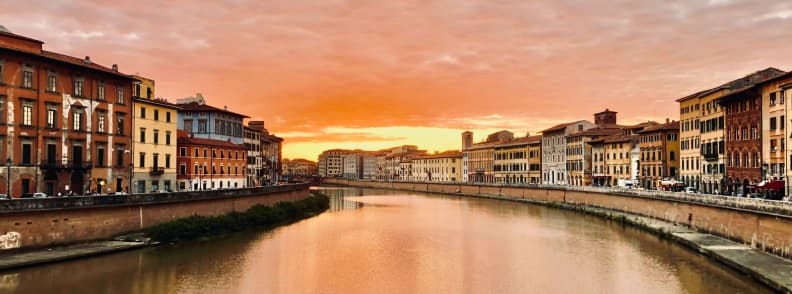
Arno River Walk
The most obvious direction is toward the river. The River Arno Pisa runs through Pisa, just like in Florence, but with fewer crowds. It divides the town, and walking along the Lungarno gives you some of the best views at sunset. Look for reflections, rowers, and sunsets over the bridges.
I walked on the northern bank of the River Arno on my second visit, and the light was perfect. The buildings glow pink, the bridges turn to silhouettes, and the crowd thins out. It was a wonderful Pisa sunset!
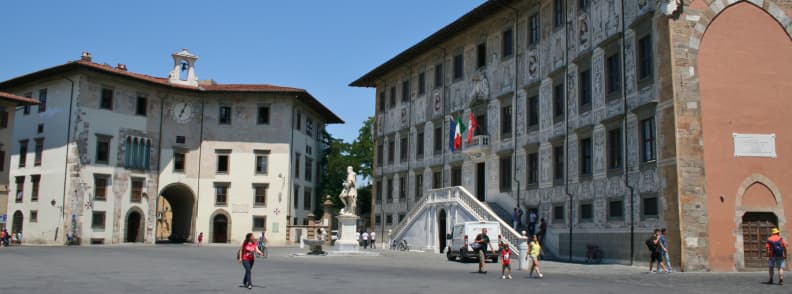
Piazza dei Cavalieri & Palazzo della Carovana
As you head from the Tower toward the River Arno Pisa, take a slight detour to Piazza dei Cavalieri. It’s not flashy, and that’s the point. This was the political heart of medieval Pisa, once the headquarters of the Knights of St. Stephen, and now one of the most peaceful public spaces in the city. Most tourists skip it, but they shouldn’t.
Piazza dei Cavalieri square is wide and almost always empty. It feels strange at first with no lines, no posing, and no tour groups. And then you realise this is Pisa without the performance. The buildings stand quiet. The benches stay shaded. And you can sit for five minutes without anyone asking you to take their photo. I enjoyed that both times I visited.
At the center of Piazza dei Cavalieri is the Palazzo della Carovana, a Renaissance masterpiece with a stone-carved façade designed by Vasari. Its symmetry is deliberate, its history layered. Today, it houses the Scuola Normale Superiore, one of Italy’s most elite universities. It’s a kind of Italian Ivy League that’s produced Nobel laureates and cultural heavyweights.
What most people don’t know is that you can visit Scuola Normale Superiore di Pisa. Guided visits are allowed by appointment, and all you need to do is email in advance. Entry is free during specific hours, and it’s worth the effort. Inside, you’ll find the Sala Azzurra, the Sala degli Stemmi, and a cloistered courtyard that students still use between classes. It’s a glimpse into the academic life of Pisa that most tourists never see.
You’re only 600 metres from the Leaning Tower of Pisa and about seven minutes on foot, but the atmosphere here is entirely different. No noise, no ticket booths, just architecture and open air. If you’re looking for a photo of Pisa that no one else takes, take it here. If you’re walking with kids, it’s a calm place to pause. And if you need a reset after the monument zone, this is where you’ll find it.
Pisa Vacation Tip: Come just before sunset. The buildings take on a warm glow, and students gather on the steps with gelato or coffee. It’s as close as Pisa gets to a golden hour that belongs only to locals.
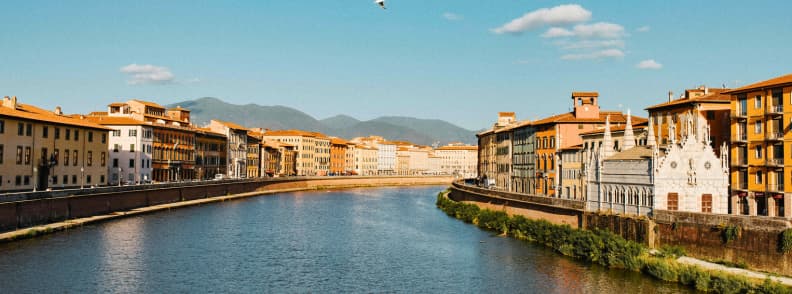
Santa Maria della Spina
Down by the water on the right bank of the River Arno Pisa, the Santa Maria della Spina is the church everyone notices but almost no one steps into. It’s small, covered in carvings, and looks more like a marble sculpture than a building. We came across it by chance on a walk. I wasn’t even looking for it, but I stopped in my tracks. It’s that photogenic. The exterior is so intricate it almost feels fragile, with lace-like spires and statues lined up across the roof. It’s pure Gothic excess, in miniature.
Built in 1230 and later restored in the 19th century, the Santa Maria della Spina once held a relic believed to be a thorn from Christ’s crown. Today, it doesn’t draw pilgrims or big tour groups. It just stands there quietly, and somehow, that makes it feel even more sacred.
It’s free to visit, but it’s usually closed. I’ve only managed to see the inside once, and it was nearly empty. The space is small and dim, but if you care about Gothic architecture or you like places that feel more like secrets than attractions, it’s worth checking the opening hours. Most days, you’ll only see the outside.
The church sits about 1.2 km from the Leaning Tower of Pisa. It’s a 15-minute walk if you take the scenic route along the river. The setting is part of what makes it special. The water reflects the façade. The buildings across the River Arno soften the background. And you get a moment of calm that’s hard to find elsewhere in Pisa’s centre.
Pisa Local Travel Tip: Even if it’s closed, go anyway. The riverside setting is one of the best spots in Pisa for photography, especially in the late afternoon when the light hits the marble and the river reflects everything back. Bring your camera.

Museo Nazionale di San Matteo
Across the river, far from the crowds around the Tower, you’ll end up at the Museo Nazionale di San Matteo. It’s a great stop if you need some quiet. There aren’t any queues. It has a modest entrance, and it gives the sense that this might be where real art lives.
Inside, you’ll find Pisa’s most important collection of medieval and early Renaissance art. There are painted crucifixes from the 12th century, wooden saints with cracked paint and worn feet, and delicate Pisan altarpieces that glow under low lights. If you’re used to museums that push you along with audio guides and camera flashes, this one feels like a relief. You’re allowed to stand still.
Many of the works here were originally housed in the city’s churches, and some are the only survivors from buildings lost to war or decay. There are sculptures by Nicola Pisano, works by Francesco Traini, and anonymous masterpieces that feel surprisingly modern in their simplicity. Take the time to look closely at everything. You can spend almost an hour here without hearing another voice.
The museum sits on the opposite side of the River Arno Pisa, in a quiet zone that few tourists cross into. If you’re someone who likes Tuscan religious art but doesn’t want to compete for space in Florence’s Uffizi, this is where you go. Museo Nazionale di San Matteo tickets cost €8, and it’s open Tuesday to Saturday. Even in summer, it stays near-empty.
Visit Pisa Without the Crowds: If you need a break from people, come here in the late afternoon. The museum is cool, quiet, and built for slow travel. It’s one of the only places in Pisa where you’ll hear your own footsteps.
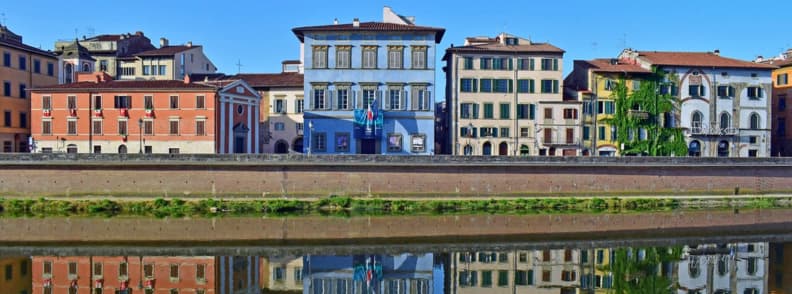
Palazzo Blu
On the Lungarno Gambacorti, across from the university quarter and just above the River Arno Pisa, there’s a building you can’t miss. It’s bright cobalt blue, with shutters that always seem half-closed against the sun. That’s Palazzo Blu, and it’s one of the most visually memorable buildings in Pisa.
Palazzo Blu hosts rotating exhibitions that range from Renaissance to street photography. The contrast between the classic interior and the modern or thematic shows works surprisingly well. You never know what you’ll get, and that’s part of the draw. The exhibition spaces are well-lit, intimate, and always professionally curated.
The schedule changes every few months, so it’s worth checking what’s on during your visit. Palazzo Blu tickets cost between €6 and €12, depending on the show. Even when it’s a big-name exhibition, the crowds stay manageable. You won’t be fighting elbows for space. If you like art but don’t want to spend half your day in a museum, Palazzo Blu is a smart, flexible stop.
Visit Pisa Like a Local: Come mid-morning, grab a coffee at a riverside café nearby, and visit when the light hits the building just right. Even if you skip the exhibit, the exterior alone is worth walking past.
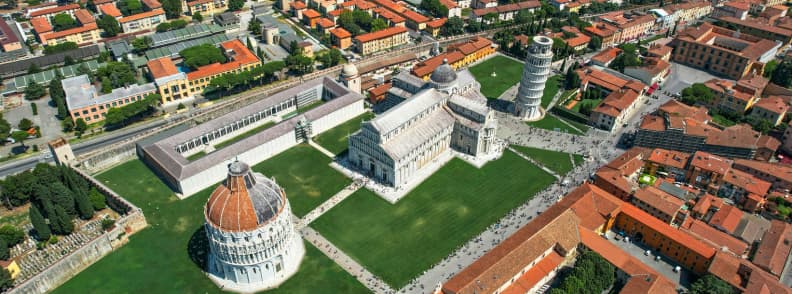
City Walls of Pisa
Behind the Leaning Tower of Pisa, there’s a quieter, higher perspective most visitors miss. You can climb a stretch of the City Walls of Pisa for an elevated view over the Piazza dei Miracoli, the rooftops behind it, and the flow of people through the square below. It’s only about 500 metres long (not a loop like Lucca’s), but it’s enough to change how you see the city.
Once you’re up there, with the Pisa Baptistery to one side and the Tower of Pisa leaning into view from a different angle, you’ll realise just how different Pisa looks from just a few metres higher. The square flattens out. The geometry becomes obvious. And the crowds shrink back into scale. It’s not physically demanding, and it’s far less claustrophobic than the Tower.
Pisa City Walls tickets cost €5. It’s one of the best alternatives to climbing the main monument, and you get to see Piazza dei Miracoli from up high WITH the Leaning Tower, too.
The entrance is tucked behind the Pisa Baptistery, and it’s easy to miss. But once you’re on the walls, you’ll see immediately why this spot is quietly popular with photographers. The light up here changes fast, and there’s space to pause. You won’t find tour groups. You won’t be rushed.
Pisa Photo Tip: Some of the best Pisa photo spots are along the wall, especially facing the back of the Baptistery around golden hour. It’s the cleanest angle you’ll get without scaffolding or crowds, just marble and sky.
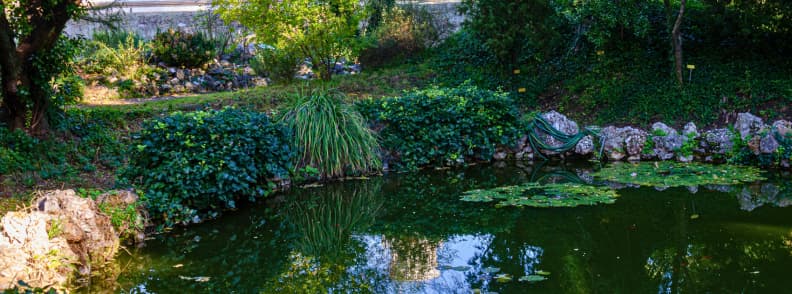
Botanical Garden Pisa or Orto Botanico Pisa
When you’re in Pisa during the summer or traveling with kids, it doesn’t take long before you start looking for shade and quiet. That’s exactly what you’ll find at the Botanical Garden Pisa, just a couple of minutes from the Tower. It’s not huge or flashy, but after the bright marble and thick crowds of the Piazza dei Miracoli, this garden feels like a real break.
The Orto Botanico di Pisa is part of the university and dates back to 1544, which makes it the oldest university botanical garden in Europe. That kind of age shows in a good way. The layout is thoughtful. There are signs in English and Italian.
The trees are tall enough to block the sun, and you can hear birds instead of selfie sticks clicking. There are medicinal herb plots, rows of cacti, a collection of rare trees, and a pond with turtles that kept the kids near me occupied for a while. Water fountains offer cool drinking water, and the paths are stroller-friendly, which makes it one of the few true family-friendly places in Pisa where you don’t have to buy anything or wait in line.
Botanical Garden Pisa tickets cost €4, and even in July, you’ll get to enjoy parts of it by yourself. You’re just steps from the monument zone, but no one’s shouting here. That contrast is what makes it work.
Visit Pisa Hidden Gems: The best time to visit the Botanical Garden Pisa is late afternoon, especially if you’re pairing it with the City Walls of Pisa. They’re within three minutes of each other, and the light, temperature, and crowd levels all get better after 16:00.
Free Things to Do in Pisa
Pisa gets a reputation for being a short, expensive stop. You take the photo, climb the Leaning Tower, and move on. But if you know where to look, there’s a lot you can do here without spending anything at all. I’ve walked the city on a budget, and some of my favourite places were completely free. Whether you’re passing through on a day trip or staying overnight, there are enough free things to do in Pisa to fill a whole day and still feel like you’ve seen more than just the postcard angle.
The city’s compact layout makes it easy to explore on foot. You don’t need taxis, tours, or transit. You can wander past Gothic chapels, through medieval squares, along the River Arno Pisa, and into shaded gardens, all without paying a cent. Even major landmarks like the Pisa Cathedral offer free entry, and there are quiet corners most tourists skip that give you a better feel for the city than the Tower of Pisa ever could. If you’re planning a trip and wondering what to do in Pisa for free, this section pulls together the best options from personal experience, including cultural stops, photo spots, and quiet places to sit and soak up the setting.
Visit the Church of San Paolo a Ripa d’Arno
Located near the river and southwest of the city centre, San Paolo a Ripa d’Arno is often called the old Cathedral of Pisa. It’s older than the Leaning Tower of Pisa, less visited, and completely free to enter. Its striped Romanesque facade echoes the more famous monuments but feels grounded and local. Step inside and you’ll find faded frescoes and an echoing interior that’s a welcome break from crowds. It’s not always open, but when it is, it offers a rare glimpse into Pisa’s religious life beyond the postcard zone.
Walk on Borgo Stretto & Corso Italia
Most visitors miss the good parts because they leave too quickly. If you head down Borgo Stretto, you’ll walk under stone arches and pass pastry shops, bookstores, and old-school cafés. This is where you’ll feel that Pisa is a university city, not a tourist trap. The buildings here are worn, the shops are small, and the pace is slow.
Across the River Arno, Corso Italia connects the train station with the Piazza Vittorio Emanuele II, full of high-street shops and bakeries. Corso Italia is the shopping street where locals buy shoes and teenagers gather after school. I didn’t go to Pisa to shop, but it’s a good street to cross if you’re headed back toward the train station.
Pisa Travel Tip: Borgo Stretto and Corso Italia are shaded, and this matters in summer.
Explore the University District Around Piazza Dante
Walk a few blocks north of Borgo Stretto, and you’ll hit Piazza Dante and the heart of university life. There’s no official sight here, but the vibe shifts. You’ll find low-key cafés, old lecture halls, and students reading on steps, debating under trees, and eating panini on the curb. It’s a part of Pisa most tourists miss, but it’s what gives the city its rhythm. If you want to see what Pisa is like without the monuments, this is the place. Free, unscripted, and full of character.
Watch Student Life in Piazza delle Vettovaglie
By day, Piazza delle Vettovaglie is home to a small produce market. By night, it becomes one of the liveliest places in Pisa, but without the tourist markup. Surrounded by student bars and casual eateries, this square is where you see Pisa’s younger energy. Even if you don’t sit for a drink, it’s worth walking through in the early evening just to observe the scene. Street musicians, students leaning out of windows, groups gathering with pizza boxes… It’s free theatre, and it’s always changing.
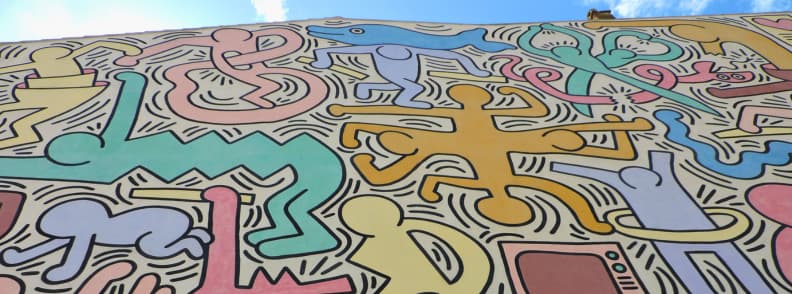
Keith Haring’s Tuttomondo Mural
Near Pisa train station, don’t miss the Keith Haring Tuttormondo mural. It’s massive, bright, and surprisingly moving and meaningful. Painted in 1989 just before Haring’s death, it wraps around the side of a church. No one really talks about it, but it’s one of the best pieces of public art in Tuscany.
If you’re traveling to Pisa with kids, the Keith Haring Tuttomondo mural is a great stop. They’ll love it!
Pisa Photo Tip: Try framing it with the tower of the church. The contrast is great for Instagram!
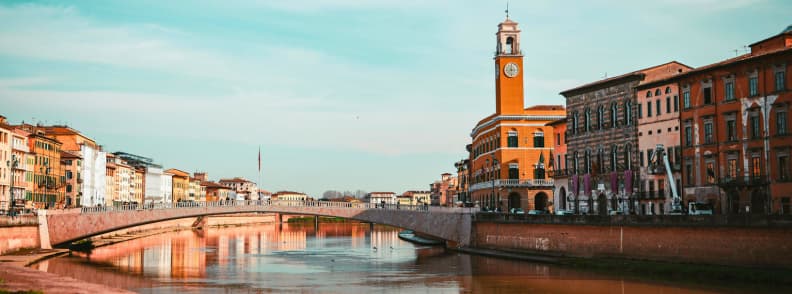
Cross the Ponte di Mezzo at Blue Hour
It sounds simple, but walking across Ponte di Mezzo just after sunset, when the last light hits the coloured facades along the Arno River, is one of the best free experiences in Pisa. Stand in the centre of the bridge, face west, and wait for the sky to shift. You’ll see reflections stretch along the water, and church towers take on a new shape. It’s where you’ll take some of your best photos in the city. And it costs nothing.
Relax in Giardino Scotto
On the southern side of the River Arno Pisa, Giardino Scotto is a public park built on top of an old fortress. It’s a favourite spot for local families, especially in the early evening, and a good break if you’re traveling with kids. You’ll find benches, playgrounds, open lawns, and the occasional cultural event. Entry is always free, and it’s one of the greenest places in Pisa that isn’t a museum garden. Bring a snack and have a picnic under the trees in this quiet corner of Pisa.

Vicolo del Vigna Street Art Gallery
This one’s personal. I stumbled into a small alley full of local art. Can’t guarantee it’ll be open when you go, but keep your eyes out near the river.
In this Alley, several Pisan artists have donated their own works in the spirit of redeveloping a shared space. This path is dedicated to the friend Maurizio Andruetto who has always believed and ideally guided this project wanted by the Associazione delle Vettovaglie.
If you’re like me and prefer to go a bit off the beaten path Pisa, just turn away from the Tower and walk. Ten minutes in any direction is enough to find quiet. If you’re into photos, the light is best from the City Walls of Pisa, along the River Arno Pisa, or the corner of Piazza dei Cavalieri at dusk.
Pisa Travel Tip: You can skip the group tours and pick one or two monuments to go inside, then spend the rest of your time walking. That’s how Pisa reveals itself.
Best Time to Visit Pisa (Weather, Crowds & Events)
My Pisa trips taught me how much timing matters. Pisa’s compact, sun-drenched layout is ideal for slow travel, but it also means crowds build fast, heat hits hard, and your visit can shift completely depending on the time of day or month you choose. If you’re serious about making the most of your visit, the best time to visit Pisa is when you can experience the monuments without shoulder-to-shoulder tour groups and when the light is good for photos.
Pisa in Spring and Early Summer (March to mid-June)
This is my personal recommendation. Spring in Tuscany feels like a gift. It has mild temperatures, longer days, and fewer crowds. By May, the grass in Piazza dei Miracoli is glowing, the River Arno Pisa looks clean and wide, and locals are still in town before heading to the coast for summer.
Both times I visited, I saw how different the same square can feel in June. Early June brought groups, yes, but nothing unmanageable. In 2020, late June felt almost empty, it was a unique moment. Under normal conditions, though, crowds return quickly. That’s why the best time to visit Pisa Italy weather-wise is late April to early June.
If you’re planning a family trip or traveling with a baby, this window also makes it easier. Pisa in spring has stroller-friendly pavements, no heat exhaustion, and quieter cafés.
Pisa Travel Tip: If you want the best photo of the Leaning Tower of Pisa without crowds in the background, go before 8:30 AM. The light is soft, and the tour buses haven’t arrived.
Pisa in High Summer (Late June to August)
This is when most visitors arrive and when I’d personally avoid it, if I could. The temperatures hit 30-35°C, shade is hard to find in the monument zone, and lines stretch long, even with pre-booked tickets. For families, this season means shorter tempers and tougher logistics.
However, summer in Pisa is not without its rewards. June 16 and 17 are two of Pisa’s biggest annual events. The Luminara di San Ranieri, held every year on June 16, transforms the River Arno Pisa into a glowing riverbank. Locals light over 70,000 candles on the palazzi, and small lights float on the water. I wasn’t there for the actual night, but saw some of the setups, and I’d go back just for that.
The next day, June 17, is San Ranieri Day, Pisa’s patron saint, with a full procession and festivities around the square. Crowded, yes. But meaningful. Pisa doesn’t have many festivals that tourists get to see up close, and this one is genuine.
Then there’s the Gioco del Ponte, Pisa’s strangest tradition. Held in late June, it’s a mock battle where teams from opposite sides of the Arno push a heavy cart across the bridge in full costume. It’s loud, messy, and entirely local. If you’re into odd historical events, plan for it.
Pisa Local Tip: Even during festivals, the hidden gems in Pisa stay quiet. While everyone crowds the bridge, you can slip into Palazzo Blu or find a bench near Santa Maria della Spina and have it to yourself.
Pisa in Autumn (September to November)
If you’re visiting Tuscany later in the year, Pisa can still work. September keeps warm weather without the August rush. By October, you’ll need a jacket, and some places (especially near the beach in Marina di Pisa) start closing for the season. Rain becomes more likely in November, but that also means emptier museums and lower accommodation prices.
For photography, this season is underrated. The best time to photograph the Leaning Tower Pisa is either spring or early autumn. There is no haze, rich light, and lower sun angles. If you’re building content or collecting shots for a blog or Instagram, this is the time to go.
Pisa in Winter (December to February)
You can visit Pisa in winter, but don’t expect a magical atmosphere. Some monuments adjust hours or close for maintenance. The grass in the square turns patchy. The wind off the Arno feels colder than it should. But if you want to avoid crowds altogether, this is your chance.
There’s a small Pisa Christmas market, usually in the historic centre. It’s not a reason to travel by itself, but if you’re already in Florence or Lucca, it could be a nice bonus. If you do visit during winter, book accommodation with heating because not all budget places are well insulated.
Visit Pisa Tip: Winter is when Pisa belongs to locals again. I wouldn’t recommend it as a first visit, but if you’ve already been, you might see the city differently.
So, When Is the Best Time to Visit Pisa Italy?
If I had to pick, I’d go with May or very early June. You get the best weather, moderate prices, and the chance to experience Pisa on foot without melting. If your goal is to photograph the Pisa photo spots at their best, this is also your window.
If you’re curious about festivals, mid to late June offers more, but book early. If you’re prioritising budget and avoiding crowds, consider September or October. If you’re combining Pisa with a wider Tuscany trip, align your visit with your base’s logistics because trains, weather, and events vary by region.
What matters most is not just when you visit, but how long you stay. I’ll cover that next. For now, know this: Pisa rewards timing. Come early, come slow, and you’ll see why it’s worth more than a photo stop.
How Many Days Do You Need to Visit Pisa?
Pisa gets treated like a pit stop. You come in, snap the photo, grab a gelato, and leave. But that approach misses what the city actually offers. I’ve done Pisa day trips twice: once by car from Florence, once by bus from our boat docked on the Arno. I never spent the night, but I did spend time. And that made the difference. So, how long do you really need to visit Pisa? It depends on what kind of trip you’re planning.
A Half-Day in Pisa
If your time is short or you’re passing through by train, a half-day in Pisa is enough to see the Leaning Tower of Pisa, walk around the Piazza dei Miracoli, and get a quick look inside the Pisa Cathedral. You can take your iconic photo, grab a bite, and be back on your way. It works logistically because Pisa’s main sights are close together and easy to reach from either Pisa Centrale or Pisa S. Rossore stations.
But it also feels rushed. You’ll probably spend more time navigating ticketing queues and dodging crowds than actually seeing anything. And if you’re hoping for a calm experience, this version of Pisa might leave you underwhelmed.
One Full Day in Pisa
This is the sweet spot. If you’re doing a Pisa day trip from Florence, arrive before 9 AM and plan to leave after sunset. With a full day, you can go inside one or two monuments, visit a museum like the Museo Nazionale di San Matteo, walk along the River Arno Pisa, and eat a real lunch instead of a quick pizza. You’ll also have time to visit hidden gems in Pisa like the Keith Haring Tuttormondo mural, the Botanical Garden Pisa, or the artist alley I stumbled into by accident.
I’ve done it this way, and it felt right. I didn’t need to rush. I didn’t feel cheated. And I left knowing I saw more than just the postcard shot.
If you’re traveling with kids, a full day also gives them breathing room. You can pace the day around their needs, add in breaks at shaded spots like Piazza dei Cavalieri, or stop for gelato without watching the clock.
Staying Overnight in Pisa
This is where most guides start hedging, but here’s my honest take. You don’t need to spend the night in Pisa. But if you do, you’ll experience the city differently. After the buses leave, the square empties. Locals take over again. Students head to cafés. The light softens. And Pisa breathes.
If you’re planning a Pisa weekend trip, staying overnight would make sense. It’s a good base if you’re exploring nearby towns like Lucca, San Miniato, or even Viareggio. The city is well connected, with direct trains across Tuscany. You can easily plan a Pisa and Lucca day trip itinerary, or head out to Cinque Terre and return in time for dinner.
A Pisa 3 day itinerary isn’t necessary unless you’re moving slowly or using Pisa as a hub. But a night? That could change your impression of the place entirely.
How Long Should You Spend in Pisa?
If you’re asking how many days in Pisa is enough, my answer is: one full day. It gives you time to see the essentials, avoid the rush, and explore the backstreets that show you what Pisa is really like. If you’ve only got half a day, go early, plan tightly, and accept that it’ll be surface-level. If you’ve got two days or more, slow down. You can even use Pisa to reach other corners of Tuscany. Eat better. Sleep closer to the sights. Walk longer.
- Pisa one day itinerary? Perfectly doable.
- Pisa itinerary for family travel? One night gives you flexibility.
- Pisa weekend trip? Worth it if you are a slow traveler or you’re visiting nearby towns.
- Complete Pisa itinerary for weekend trip? Coming up next!
Once you know how long to stay, the next question is what to do with your time hour by hour, meal by meal. And that’s what we’ll plan next.
Pisa Itineraries: 1, 2, or 3 Days
There’s no single right way to visit Pisa. But having done two Pisa day trips and having walked most of the city both times, I’ve seen what fits in a few hours and what needs longer. In addition, I’ve helped many, many friends and clients plan their trips to Pisa, and I’ve received only positive feedback every time.
These sample itineraries are built for real travel: slow mornings, short distances, and time to enjoy the unexpected. I’ve also designed them with families, budget travelers, and anyone doing a Pisa weekend trip in mind.
Pisa One Day Itinerary
Start early. If you’re arriving in Pisa by train, get off at Pisa S. Rossore instead of Centrale. It’s smaller, quieter, and only a five-minute walk to the Piazza dei Miracoli. The Leaning Tower area fills quickly, so being there before 9 AM helps. This is when you can get the best photos with clean light, fewer crowds, and a peaceful lawn.
Buy Pisa all inclusive tickets in advance if you plan to go inside the monuments. Begin with the Pisa Cathedral, then the Pisa Baptistery. I’d personally skip the Pisa Tower climb unless it’s your first time and you’ve planned your day around it. Just keep in mind that you’ll need a time slot, and kids under eight aren’t allowed. The interior isn’t that remarkable, and you won’t be up there long.
By mid-morning, head to Piazza dei Cavalieri. It’s never busy. You’ll find benches, shade, and striking Renaissance architecture, especially the Palazzo della Carovana. This is a good moment to pause and let the city settle around you.
Walk toward the River Arno Pisa, passing through Borgo Stretto for a coffee or pastry. This was my favourite part of the route. I just loved the arcades, independent shops, and seeing a few locals walking their dogs. Once you reach the river, cross to see the Santa Maria della Spina, then head east toward Palazzo Blu or the Museo Nazionale di San Matteo, depending on your interest.
For lunch, avoid the overpriced spots near the Pisa Tower. Walk inland and/or ask locals. I’ve made mistakes here (I once had a very forgettable slice of pizza), which is why I now make a point to recommend better options later in this guide.
End your day with a slow walk along the Arno River. The light is best between 6 and 8 PM. The river reflects the buildings, the streets quiet down, and you finally get to experience Pisa at its best.
Pisa Weekend Itinerary (2 Days)
If you’re staying overnight, you can spread out and explore Pisa without rushing. Start your first day with the Leaning Tower of Pisa and the other monuments in the square. Don’t try to fit in too much, and give yourself time inside the Pisa Cathedral. If the line is short, visit the Museo dell’Opera del Duomo.
In the afternoon, explore the city walls of Pisa for an overhead view of the monuments. Then walk to Piazza dei Cavalieri and onward to the river. If you’ve got kids, stop at the Botanical Garden Pisa. It’s just next to the monuments, shaded, and quiet.
Evening is where staying overnight pays off. After the buses leave, Pisa feels different. Locals return to the piazzas, students come out for aperitivo, and the centre relaxes. You won’t need to search hard for a good view of the Pisa sunset over the Arno River.
On day two, explore the southern side of the city. Visit the Keith Haring Tuttormondo mural, especially if you’re with children. It’s bold and full of movement, they’ll like it. Nearby, the Corso Italia area gives you a glimpse of local daily life. You can end your visit with a stop at Palazzo Blu if there’s a temporary exhibit on.
From here, you’re in easy range of the station or the PisaMover if you’re heading to the airport.
Pisa 3 Day Itinerary
Three days is more than Pisa needs, but it can work if you’re mixing day trips. Pisa makes a smart base if you’re traveling without a car and want to see Tuscany without packing and unpacking every night.
Spend your first day exploring the monuments, then move outward: day two in Lucca, and day three at the coast. You can do a Pisa and Lucca day trip itinerary on regional trains in under an hour total travel time. Trains are cheap and reliable. Lucca’s walls, towers, and piazzas make a perfect match with Pisa.
Alternatively, take the train to Viareggio or even catch a regional connection to Cinque Terre. It’s a longer day, but still possible.
What you’ll love about using Pisa this way is that everything works logistically. Trains run often. The city is walkable. Food is affordable. You don’t waste time navigating or planning.
If you’re building a complete Pisa itinerary for weekend trip plans, this structure gives you flexibility: one day for monuments, one for the backstreets, one for the region. What matters most is not how many days you stay, but how you use them. And if you’re walking rather than rushing, Pisa rewards you.
Pisa for Different Travelers. Families, Couples, Solo, and Budget Tips
Most guides write about Pisa like it’s one-size-fits-all. But it’s not. I saw firsthand how different the same city can feel depending on who you’re traveling with. Some things worked beautifully. Others felt flat. If you’re wondering whether Pisa fits your trip style, here’s what I’ve learned.
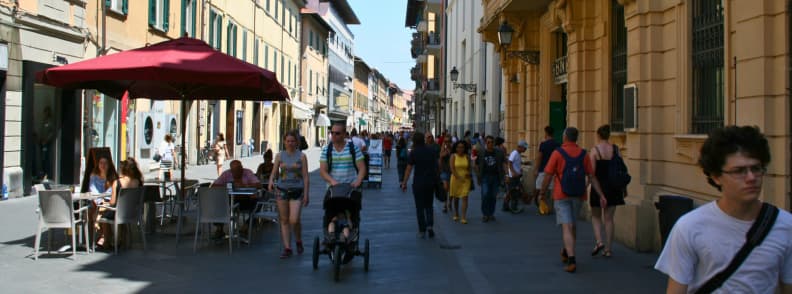
Pisa with Kids
Let me be honest: Pisa isn’t the most exciting city for young children. The monuments are impressive, yes, but once you’ve taken the Leaning Tower photo and wandered the square, the rest of the experience can be short on interaction. Most of the museums are quiet, church-focused, or academic. If your kids love history, architecture, or taking photos, they’ll find things to enjoy. If they need playgrounds, hands-on exhibits, or animals, Pisa doesn’t offer much.
That said, it’s flat. The distances are short. The monuments are outdoors. That makes it one of the more manageable cities for family travel in Italy. You can bring a stroller, take breaks without needing transport, and avoid uphill climbs. There’s space to run around in Piazza dei Miracoli, and the Botanical Garden Pisa gives you some shaded downtime. The Keith Haring Tuttomondo mural near the train station also works as a colourful stop for kids who like art or movement.
If you’re coming with babies or toddlers, book family friendly hotels in Pisa centre so you can easily return for a midday nap. Stick to short sightseeing bursts and low-key meals.
Pisa for Couples
The first time I saw Pisa was with my family. The second time was with my husband, as part of our sailing trip along the Italian coast. Same city, different mood. And it worked surprisingly well as a quick and romantic city break.
You can walk the whole town hand-in-hand. Watch the sunset over the River Arno Pisa. Have a long lunch at a café off the main roads. Find quiet streets behind Borgo Stretto and wander without a plan. In the evening, when the crowds thin out, the Pisa Tower and Cathedral are beautifully lit, and the city feels softer.
If you’re traveling as a couple, especially on a short Tuscany trip, Pisa makes a calm, low-pressure stop. You won’t have the pressure of seeing a dozen sights. You can just walk, eat, and enjoy the architecture.
Pisa for Solo Travelers
Pisa is one of the easiest solo travel cities in Italy. It’s safe, compact, and well-connected. You can walk everywhere, there’s no need for a car, and the main train station has regular links to Florence, Lucca, Rome, and the coast. I walked most of the city alone, even when I wasn’t technically traveling solo, and never felt unsafe.
The pace is relaxed. You can visit museums at your own speed, grab food when you’re ready, and take your time with photos. It’s not a nightlife city, but it’s good for reflection and quiet exploration.
Pisa on a Budget
Pisa is a gift if you’re watching your spending. The big landmarks can all be seen from the outside for free. Entrance to the Pisa Cathedral is free with a timed ticket. The city is walkable, so no public transport is needed. If you want to go inside everything (the Leaning Tower of Pisa, the Baptistery, the Camposanto, and two museums), you’ll spend around €27. But you don’t have to do that to enjoy Pisa.
Food gets expensive around the Pisa Tower, but just a few blocks away, prices drop fast. Look around Borgo Stretto or Corso Italia for better value. Water fountains are scattered throughout the centre. Many churches and small museums are free or donation-based. And since Pisa isn’t saturated with international tourism like Florence or Venice, prices for hotels and Pisa accommodation are often 20-30% cheaper.
You can easily visit Pisa on €40–€50 for the day, including meals, museum entry, and coffee.
Pisa for Luxury and Accessibility
There are a few boutique hotels and well-rated Airbnbs in Pisa, but it’s not a city known for luxury. If you’re after 5-star treatment, you’ll find more options in Florence. That said, the simplicity of Pisa means fewer logistics, which can feel like a luxury in itself.
For travelers with mobility needs, Pisa is easier than many historic Italian cities. The main sights are flat and accessible. The square has ramps, the PisaMover from the airport is step-free, and the central zone is relatively smooth. The Pisa accessible travel guide in PDF lists the exact access points for the monuments and public toilets.
The Pisa Tower climb is not accessible. There’s no lift, and the stairs are narrow. But the view from the ground is excellent, and you’re not missing much.
Pisa works for more travelers than you’d think. Families get easy logistics. Couples get space and sunsets. Solo travelers get freedom. Budget travelers save money without cutting corners. You don’t have to climb the Leaning Tower or stay overnight to enjoy Pisa, but depending on how you travel, you might find that one night here makes a big difference.
Day Trips from Pisa (Where to Go & How to Get There)
Because Pisa is so well connected, it works just as well as a base as it does a stop. I’ve used it both ways. The Pisa train station is within walking distance from the Tower if you’re not dragging luggage, and trains head out in every direction: coast, countryside, hill towns, and cities. If you’re here for two or three days, building in a Pisa day trip is one of the smartest ways to get more out of your stay.
Florence to Pisa Day Trip or Pisa to Florence?
Most people do it in reverse. They stay in Florence and do a Pisa day trip from Florence. That’s what I did the first time. I drove in from Florence with my family and visited Pisa as a break from the larger crowds. The train from Firenze Santa Maria Novella to Pisa Centrale takes about an hour and costs around €9. Trains run all day, and you don’t need to book in advance.
But it works both ways. Pisa is cheaper, quieter, and far less intense than Florence. That makes it a good base if you’re a slow traveler. If you’re asking how to get from Florence to Pisa, the easiest way is still by train. Driving is doable (I did it), but you’ll have to deal with ZTL zones and expensive parking.
Tuscany Travel Tip: If you take the train, sit on the left side heading west to see occasional views of vineyards and olive groves outside Pontedera.
Lucca from Pisa
If you want something beautiful, compact, and slow, Lucca from Pisa is my top choice. The train takes just 25 minutes. You’ll arrive outside the city walls, and the whole old town is walkable.
Lucca has a completely different rhythm from Pisa. It has more cafés, more bikes, and fewer crowds. You can cycle on the ramparts, climb the Torre Guinigi, and sit in Piazza dell’Anfiteatro for lunch.
Many travelers ask if they can do both in one day. Yes, a Pisa and Lucca day trip itinerary works. If you only have one day for both, start early in Pisa (be there when the Leaning Tower opens), then head to Lucca after lunch. You’ll be able to see both cities without rushing too much.
Cinque Terre from Pisa
It’s longer, but doable. Trains from Pisa to La Spezia take about 1 hour and 15 minutes. From there, you transfer to the local Cinque Terre train. If you’re trying to fit it into one day, aim for just two villages from Cinque Terre (maybe Manarola and Vernazza). A Pisa and Cinque Terre day trip is a lot, especially in summer, but it’s a way to combine art and architecture with cliffs and the sea.
For me, this kind of day only works if you’re staying multiple nights in Pisa. It’s not a day trip I’d attempt with young kids unless they’re already used to long train journeys.
San Gimignano and Siena from Pisa
These take a little more planning. Trains from Pisa to Siena require a change in Empoli, and the journey takes around 1 hour and 45 minutes. The route to San Gimignano is more complex: train to Poggibonsi, then a bus. It’s possible, but not ideal as a same-day return unless you start very early and move fast.
Still, both towns offer something very different from Pisa. Siena is medieval and serious, full of history and tradition. San Gimignano is vertical, photogenic, and a little unreal. If you’re on a Pisa weekend trip and want to add one town, choose Siena for culture or San Gimignano for photos.
Viareggio and Marina di Pisa
If you’re visiting in summer and want to end the day with a swim, head to the coast. Viareggio is about 30 minutes by train and has a long beach with shallow water. On my first trip, that’s exactly what we did: Pisa in the morning, Viareggio in the afternoon. It wasn’t fancy, but it was good to unwind after sightseeing.
Marina di Pisa is closer, at about 25 minutes by bus. It’s smaller and more local. If you have a car or come by boat, like I did the second time, it’s the most convenient beach access. The water here is calmer, and you’ll mostly find local families. There are beach clubs, no rows of umbrellas… just breakwaters, rock pools, and sand.
Tuscany Vacation Tip: Trains to Viareggio are more frequent than buses to Marina di Pisa. If you’re short on time, go with what’s simpler.
The best day trips from Pisa depend on your pace, your budget, and whether you’re traveling with kids or solo. Trains make it easy, distances are short, and every direction leads somewhere worth your time. Pisa may not be the final destination, but it makes an excellent starting point.
Where to Stay in Pisa (Best Areas, Hotels, and Local Advice)
I’ve never slept in Pisa, but I’ve researched where to stay in Pisa in depth for friends and clients who have asked for my help in planning their itineraries. And when I visited, I made it a point to walk through different neighbourhoods, look at where the hotels were, and ask myself: Would I want to stay here next time? The answer depends on your travel style. Pisa is compact, walkable, and divided into a few distinct zones. If you’re wondering where to stay in Pisa, here’s how to choose.
Near the Leaning Tower of Pisa, It’s Convenient, But Crowded
Staying close to the Leaning Tower of Pisa means you’ll be near the action. If you’re planning a short trip and want to maximise your sightseeing time, this is the obvious choice. From your door, you’ll walk straight into Piazza dei Miracoli in five minutes or less. It’s a great location for early morning photography or visiting the tower before the crowds arrive. And if you’re only in Pisa for one night, it makes logistical sense.
But it’s also the most tourist-heavy area. Restaurants here cater to the day-tripper crowd. They’re expensive, bland, and often poorly reviewed. The evenings are quieter once the buses leave, but there’s not much local life.
If you’re travelling with kids, staying here means less walking and easier breaks. For couples or solo travellers looking for something more atmospheric, this area might feel too commercial.
Pisa Travel Tip: If you do choose a hotel near the Leaning Tower, make sure it’s on a side street. The closer you are to Via Santa Maria, the noisier it gets, especially in high season.
Borgo Stretto and the Historic Centre Are Local, Lively, and Walkable
This is the area I’d stay in if I were booking tomorrow. The streets around Borgo Stretto are some of the most charming in the city. You get arcades, family-run cafés, and a slice of student life that still feels local. You’re halfway between the monuments and the river. It’s shaded, calm, and close to everything.
What I like most about this zone is the atmosphere. You’ll find aperitivo spots with outdoor tables, bookstores, small shops, and just enough distance from the tourist noise. The buildings are worn in the best way with faded shutters, stone facades, and laundry drying across alleys.
Many small B&Bs and boutique hotels are tucked into this area. If you’re looking for something mid-range or stylish, this is your sweet spot.
Pisa Centrale Station Area Is Budget-Friendly, But Less Scenic
If you’re arriving late or leaving early by train, staying near Pisa Centrale can be practical. You’ll find cheaper hotels, hostels, and guesthouses here. It’s functional, not pretty. The walk to the Pisa Tower takes about 25–30 minutes. You’ll pass through Corso Italia, Pisa’s main shopping street, which can be interesting, but it’s not as charming as the historic centre.
This area has more budget options than anywhere else in Pisa. If you’re looking for cheap places to stay in Pisa or a solid Pisa hostel, this is where you’ll find them. The downside is the atmosphere. It’s busier, less polished, and not ideal for night walks.
If you’re traveling solo and on a budget, it’s a practical base. If you’re traveling with kids or prioritising charm, look elsewhere.
Family-Friendly Hotels and Apartments
If you’re coming to Pisa with young children, location matters more than stars. You want walkability, shade, and somewhere you can pop back to midday. Look for small hotels or rentals near the Botanical Garden Pisa or tucked between Piazza dei Cavalieri and the river.
Some family-friendly hotels in Pisa offer triple or quad rooms and small kitchens. If you’re staying two nights or more, I recommend checking local Airbnbs or apartment hotels in quieter streets. Avoid anything directly facing Piazza dei Miracoli unless it’s well-reviewed for noise control.
Pisa Camping Options
Yes, you can camp near Pisa. Just north of the monuments, Camping Village Torre Pendente offers tent pitches, cabins, and camper spots. It’s basic, affordable, and within walking distance of the Tower. If you’re on a road trip or traveling with a van, this is a practical, budget-friendly option for Pisa camping.
Pisa Camping Tip: Even if you stay in a cabin, bring earplugs. The area is quiet at night but gets noisy early when tour groups arrive.
Pisa Airbnb and Apartments
I haven’t stayed in an Airbnb in Pisa, but I always browse them when planning future trips. What I like about Pisa’s rental market is that it’s still reasonably priced compared to Florence or Venice. You can find full apartments for the price of a mid-range hotel room. Many are in old buildings with character, with stone staircases, wooden beams, and tiled floors.
If you’re staying two nights or more, and especially if you’re traveling as a family or group, an apartment gives you flexibility. At your Pisa accommodation, you can make breakfast, do laundry, and skip restaurants when you want to. Just double-check the reviews for AC because summers get hot, and not all buildings are well equipped.
Choosing where to stay in Pisa depends on what you want from your visit. If it’s your first time and you’re here to see the sights, sleep near the Leaning Tower. If you want local life, better food, and charm, book Pisa accommodation near Borgo Stretto. If you’re watching your budget, the Pisa train station area works. Pisa is small enough that no matter where you stay, you’ll be able to walk to everything. But where you sleep still shapes how you see the city and how much you enjoy it.
What to Eat in Pisa. Local Dishes and Where to Try Them)
I’ve eaten badly in Pisa, but that’s on me. You can also eat very well, and that’s part of why I’m writing this section the way I am: to help you skip the tourist traps and head straight for what’s good. Pisa doesn’t shout about its food the way Florence or Bologna does, but it’s quietly solid. The city leans into rustic Tuscan ingredients like beans, bread, chickpeas, and slow-cooked meats, and keeps things regional.
The restaurants near the Leaning Tower of Pisa cater to quick-turn tourists. Most are forgettable. Walk ten minutes in any direction and the menus change, the prices drop, and the experience improves. Here’s my Pisa foodie guide, teaching you how to eat like you belong in Pisa, even if you’re only staying for one day.
What to Eat in Pisa Italy Local Food
Pisa’s cuisine is Tuscan, but more coastal than you might expect. Seafood shows up often. So do beans, saltless bread, and olive oil that actually tastes like something. Most Pisa local food is simple, and little is photogenic. But if you like comfort food that’s tied to place, you’ll eat well here.
If you want authentic Tuscan food in Pisa, then try Bordatino, a thick soup made from cornmeal and black cabbage. You won’t find it everywhere, and it’s seasonal, but it’s one of those dishes that tastes like someone’s nonna made it. Mucco Pisano, a rare breed of Pisan cattle, appears in ragù and steaks. It’s lean, dark, and surprisingly tender. Cecina, a chickpea flour flatbread, is cheap and filling, and often eaten folded into focaccia or as a snack with beer.
You’ll also see Pappa al Pomodoro, Ribollita, and Crostini with liver pâté, all typical of inland Tuscany. Pisa leans slightly more toward fish than Florence does. Expect anchovies, cod, and shellfish, especially in stews.
Finish with a slice of Torta co’ Bischeri, a chocolate rice pie wrapped in a rustic pastry shell. It’s originally from nearby Pontasserchio, but locals in Pisa treat it as their own.
Pisa Foodie Tip: You’ll often find better food in spots that don’t have English menus. If you’re unsure, ask the server what they’d eat and trust them.
Best Restaurants in Pisa Locals Recommend
I didn’t love the pizzeria I picked on my second visit. It was too close to the Leaning Tower and aimed at passing tourists. Since then, Italians have taught me better options, places that locals actually return to.
Trattoria S. Omobono is often mentioned for its seasonal cooking and traditional dishes. It’s small, affordable, and a short walk from Piazza dei Cavalieri. Osteria dei Cavalieri is slightly more upscale but still grounded in Tuscan classics like house-made pastas, slow-cooked meats, and good wine by the glass. It’s not cheap, but you get value.
For something casual, try L’Ostellino. It’s a tiny sandwich shop near Pisa’s Tower that doesn’t feel like a trap. The panini are generous, and the ingredients are solid. Think cured meats, savory pecorino, and truffle spreads. You’ll probably eat it on a bench outside, but it works.
I’ve also bookmarked Il Crudo for a return visit. It doubles as a wine bar and gelateria, with seasonal flavours and surprisingly good sorbet.
If you’re looking for Pisa restaurants with real personality, these places stand out because they stay busy even when the tourists leave.
Pisa Restaurant Tip: If you’re visiting on a weekend or holiday, book ahead. Even casual places fill up quickly around 8 PM.
Pisa Food Guide for Coffee, Aperitivo, and Sweets
Start your morning with a strong caffè at Filter Coffee Lab near the Arno. It’s modern, spacious, and student-friendly. It’s not a classic Italian bar, but it makes excellent espresso and serves actual filter coffee if that’s your thing.
For something more traditional, Bar La Borsa in Piazza della Borsa delivers the proper Italian experience: locals at the counter, fast service, and decent pastry options. Prices are fair, and it’s great for people-watching.
In the evening, head toward Piazza delle Vettovaglie. It’s the closest thing Pisa has to a nightlife zone. You’ll find aperitivo deals (snacks and a drink for €6-8) and plenty of outdoor seating. La Cantina di Tipì is a good pick for natural wines and small plates.
When it comes to gelato, avoid the overly colourful piles near the Tower of Pisa. Look for signs that say artigianale and check for seasonal flavours. Gelateria De’ Coltelli and La Bottega del Gelato are both worth the short walk from the centre.
Local Pisa Tip: Want a view with your coffee? Go to Caffè dell’Ussero on Lungarno Pacinotti. It’s one of the oldest literary cafés in Italy. It’s slightly faded but with history in its walls.
Pisa Cooking Classes and Food Experiences
If you’re staying more than a night, Pisa cooking classes can give you a deeper connection to Tuscan food. Several locals offer private or small-group classes, usually focused on pasta, tiramisu, or traditional sauces. Most take place in home kitchens or agriturismi just outside the city.
It’s not something I’ve tried in Pisa yet, but it’s definitely on my list. It’s especially useful if you’re traveling with kids or want a non-museum activity that still feels cultural.
Pisa won’t overwhelm you with choices, but if you skip the obvious and walk a little, you’ll find satisfying meals rooted in place. What I like best is that the food here looks and tastes real. It’s not curated for Instagram, it’s not priced for cruise ship tourists. It’s the kind of eating that reminds you you’re in Tuscany, even if you’re just stopping for the night.
How to Get to Pisa. Flights, Trains, Cars & Sailboat Access
Pisa is easy to reach. That’s part of why it’s so popular for day trips and one-night stays. Whether you’re flying in, arriving by train, driving across Tuscany, or doing something less conventional (like sailing the coast and docking nearby, like I did the second time), you won’t struggle with logistics. The city is compact, the connections are reliable, and everything’s close together once you arrive.
Flying to Pisa
The main airport, Pisa International Airport (PSA), is only 2 km from the city centre. It’s served by low-cost carriers like Ryanair and easyJet as well as regular airlines. You can fly here directly from several major European cities, including London, Paris, Madrid, and Frankfurt. That makes Pisa a good entry point for Tuscany if you’re coming from abroad.
From the airport, the PisaMover gets you to the train station in five minutes. It’s an automated shuttle that runs every 5-8 minutes between the terminal and Pisa Centrale. A one-way ticket costs €7. The station is a short walk from most central hotels and B&Bs.
If you’re landing with kids, strollers, or luggage, this setup is smooth. There are no buses, no long transfers, and almost no waiting.
Pisa Travel Tip: Skip taxis unless absolutely necessary. Pisa is one of the few cities in Italy where the airport transfer by public transport is faster than by car.
Getting to Pisa by Train
This is how most travellers arrive and for good reason. Pisa is part of the regional train network, with frequent connections to Florence, Lucca, La Spezia, and Livorno. If you’re coming from Florence, direct trains from Santa Maria Novella take around one hour and cost €9. From Lucca, it’s just 25 minutes. From Rome, expect a journey of about three hours with a transfer in Florence.
There are two train stations in Pisa: Pisa Centrale, the main hub, and Pisa S. Rossore, which is closer to the Tower. If you’re arriving specifically to see the monuments and then leave, get off at S. Rossore. It’s a five-minute walk to Piazza dei Miracoli, compared to 25 minutes from Centrale.
Pisa Train Travel Tip: S. Rossore is an unmanned stop. There are no ticket machines or staff. Buy your train ticket in advance or use the Trenitalia app to avoid a fine.
Driving to Pisa
Like I said, we drove to Pisa on my first trip. We were based in Florence and did road trips to smaller Tuscan towns. Driving to Pisa was simple enough, but parking near the centre isn’t.
Pisa has a ZTL (Zona a Traffico Limitato) that restricts access to central streets for non-residents. If you drive in without permission, you’ll be fined, even if your GPS sends you that way. Park in the paid lots outside the centre and walk in.
We used the Parcheggio Via Pietrasantina, which is large, monitored, and about a 15-minute walk from the Tower. It’s cheap (around €2 per hour) and easy to find. From there, you can reach the monuments via a shaded path.
Pisa Vacation Tip: Always check if your accommodation offers ZTL access. If not, don’t risk it. Even a quick detour through the wrong street will trigger a fine.
Arriving by Sailboat or Ferry
Most people won’t do this, but I did. On our second trip, we sailed the coast of Italy and docked at Nautica 180 Pisa, a small marina about 10 km from the centre. From there, we caught a local bus into town.
Wondering how to get to Pisa from Marina di Pisa? The ride takes around 30-40 minutes, depending on traffic. It wasn’t scenic, but it was smooth and straightforward. There are other docks closer to Marina di Pisa, but Nautica was calm, safe, cheap, and practical.
Sailing to Pisa Italy gave us a very different view of the city. The approach is flat and quiet, with long canals and few crowds. If you’re chartering a boat or cruising the coast, Pisa is a logical inland break.
Pisa Vacation Advice: From Marina di Pisa, buses run less frequently than trains. Check times in advance and bring cash and a card, as some ticket machines are card-only or broken.
Getting to Pisa is easy. Whether you’re flying into Pisa Airport, hopping off a regional train, or docking on a sailboat like I did, you’ll be in the city centre within minutes. That makes Pisa one of the most accessible cities in Tuscany, and one of the easiest to add to your trip.
Getting Around Pisa. Walkability, Local Transport, and Travel Tips
Pisa is one of the easiest cities in Italy to explore without a car. I’ve done it both with family and as a couple, and in both cases, we walked almost everywhere. The centre is flat, compact, and closed to most traffic. That makes it ideal if you’re traveling with kids, pushing a stroller, or simply trying to keep logistics simple.
Is Pisa Walkable?
Yes, completely. From Pisa Centrale train station, it’s about a 20-25 minute walk to the Leaning Tower of Pisa, depending on your pace. That walk takes you through the shopping streets on Corso Italia, over the River Arno Pisa, and past some of the city’s more local cafés and markets.
Most of the main attractions (Pisa Cathedral, Piazza dei Cavalieri, Borgo Stretto, Santa Maria della Spina, and Keith Haring Tuttomondo Mural) are within a 1.5 km radius. That means you can do the entire sightseeing loop in Pisa on foot without needing to use public transport at all.
I did every visit without taking a taxi, even with heat and toddler-level stamina considerations. Pisa’s sidewalks are stroller-friendly in most areas, though cobblestones pop up around the university quarter and near the riverside.
Pisa Trip Tip: Wear decent walking shoes. The distances are short, but pavement can get slick near the river after rain, and polished stone isn’t forgiving.
Using the PisaMover
The PisaMover is a short, driverless train that links Pisa Airport with Pisa Centrale station. It runs every 5-8 minutes, and the journey takes exactly five minutes. It’s the fastest way to get from the airport to Pisa. Tickets cost €7 each way and can be bought from machines at either end or via contactless tap.
If you’re doing a Pisa day trip by air, this is the Pisa public transport system you’ll use. I didn’t use it personally since I arrived by land and sea, but I’ve seen it in operation, and it’s efficient, modern, and designed for travelers.
Pisa Travel Tip: If you’re connecting straight from a flight to a train, the PisaMover is your fastest, cheapest option. Taxis will cost at least triple and often take longer in traffic.
Pisa Public Transport (Bus & Taxi)
Public buses in Pisa are operated by Autolinee Toscane. You won’t need them to reach any of the central attractions, but they’re useful if you’re staying near Marina di Pisa, heading to Parcheggio Via Pietrasantina, or connecting to small outer suburbs.
Pisa bus tickets cost €1.50 if bought in advance from tobacco shops or machines, and are valid for 70 minutes. If you buy on board Pisa buses (when available), expect to pay more, and sometimes, drivers don’t sell them at all.
Taxis in Pisa are available but rarely needed. There’s a stand outside Pisa Centrale and another near the Tower. They charge around €10-€15 for short distances, more for airport runs. Uber doesn’t operate in most of Tuscany.
Local Pisa Tip: If you’re staying further out, take the bus to Parcheggio Via Pietrasantina and walk in. It’s shaded, safe, and avoids ZTL fines if you’re driving.
Cycling in Pisa
Pisa is a university town, so bikes are common, especially among students. But as a tourist, I wouldn’t recommend Pisa bike rental unless you’re staying longer or heading to Marina di Pisa. The city is walkable enough, and bike lanes are patchy. If you do want to visit Pisa by bike, rental shops near Piazza Garibaldi or the train station offer hourly or daily rates starting at €10.
Pisa has experimented with bike-sharing services, but they aren’t consistently reliable. If you’re traveling with older kids or teenagers, this could be a fun way to explore the riverside areas.
Getting around Pisa is simple, cheap, and low-stress. The best way to explore Pisa is on foot. You won’t need to study a transit map, worry about zones, or lose time figuring out schedules. That frees you up to focus on what actually matters: seeing the city, pausing for coffee, and noticing the things you’d miss from a moving vehicle.
Pisa Travel Tips Regarding Money, Safety, Etiquette & Local Habits
By the time you arrive in Pisa, the hard part’s over. You’ve booked the trip to Pisa, figured out where to stay, and mapped out what to see. But the small things still matter, especially in Italy, where local habits can trip up even seasoned travelers. Here’s everything I’ve learned (and wish someone had told me sooner) about the details that make travel in Pisa smoother.
Pisa Money Tips: Currency, Cards, and Cash
Italy uses the euro (€). In Pisa, you’ll be able to pay by card in most places, but not everywhere. Larger restaurants, train stations, and tourist shops all take credit and debit cards.
Do you need cash in Pisa? Smaller cafés, gelaterias, and family-run trattorias may still prefer cash. That’s especially true in local-only spots or businesses outside the main piazzas.
If you’re using card in Pisa, ATMs are easy to find, especially near Pisa Centrale and Corso Italia. They usually offer fair rates, but avoid Euronet ATMs because they often charge higher withdrawal fees. Stick to ATMs attached to Italian banks like UniCredit, Intesa Sanpaolo, or Banca MPS.
I typically carry around €50 in cash when I visit Tuscany (enough for snacks, tips, and small entries) and pay by card for meals and tickets.
Pisa Money Tip: If a place tells you the card machine is “broken”, it often means they’d rather you pay cash. Have small bills ready, especially for cafés and gelato.
Is Pisa Safe for Tourists?
Yes, Pisa is generally safe. I’ve walked the city a lot, alone, with my husband, and with family, and never felt at risk. Violent crime is extremely rare. That said, pickpocketing can happen, especially around the Leaning Tower. Like anywhere in Europe, stay alert in crowds and keep your bag zipped. Don’t sling it over a chair at a café. Don’t flash wads of cash. You know the drill.
The station area, especially around Pisa Centrale, feels scruffier than the rest of the city. It’s not unsafe, but it’s not where you linger. Walk with confidence, avoid alleyways at night, and stick to the main streets if you’re unsure.
Pisa Safety Tips: Pisa’s student population helps. The centre stays lively into the evening and rarely feels empty. If you’re walking alone, do it before midnight, and stick to well-lit streets near Borgo Stretto or the River Arno.
Pisa Etiquette and Cultural Habits
Italians aren’t overly formal, but there are a few Pisa cultural tips that help you blend in and avoid friction. Greet people. Say buongiorno (good day) or buonasera (good evening) when entering a shop or café. It’s expected and appreciated. Say grazie and per favore. If you speak even a little Italian, use it, and people will usually meet you halfway. That’s basic Pisa etiquette.
Wondering how to behave in Pisa restaurants? Don’t expect fast service. Meals are meant to be slow. Waiters won’t bring the bill unless you ask (il conto, per favore). If you’re in a hurry, let them know early on. In cafés, standing at the bar is cheaper than sitting at a table.
Tipping in Pisa isn’t required, but rounding up is appreciated. Leave €1-€2 after a meal, or round to the nearest 5. Taxi drivers don’t expect a tip, but again, rounding up is fine.
Pisa Tourist Tip: Don’t order a cappuccino after 11 AM, it’s a dead giveaway that you’re a tourist. Espresso is the go-to after lunch or dinner.
Do People Speak English in Pisa? Do you need to speak Italian in Pisa?
People speak English in Pisa, but how much depends on where you are. Near the Leaning Tower of Pisa, almost everyone working in tourism speaks basic English. In the more local neighbourhoods, older shopkeepers may not. Younger people and students usually do. I’ve gotten by easily with basic Italian greetings and polite phrases, so don’t worry too much about language in Pisa Italy.
Menus in tourist-heavy zones are often multilingual, but that doesn’t always mean the food is good. In fact, some of the best meals I’ve had in Italy were at places where no one spoke English and the menu was scrawled on a blackboard.
Italy Travel Advice: Even if your Italian is bad, saying a few words shows respect. Try Scusi, parlo poco italiano (Sorry, I speak little Italian). It opens doors.
Pisa is one of those cities that’s easy to navigate but richer when you take your time. Knowing how people live here (how they eat, shop, and speak) helps you move through the city with more confidence and less stress. These are the small things that turn a visit into a real experience.
When Is Pisa Least Crowded? How to Avoid the Crowds in Pisa
Pisa sees millions of visitors each year, and most of them concentrate in a single square, often at the exact same hour. I’ve experienced both ends of the spectrum: dodging photo groups in front of the Leaning Tower of Pisa, and standing alone in the square early in the morning. If you want to enjoy Pisa without elbowing through crowds, timing matters more than anything else.
What Is the Least Busy Time to Visit Pisa?
Early morning, any time of year, is when Pisa breathes. If you arrive by 8:00 AM, even in peak season, you’ll have Piazza dei Miracoli mostly to yourself. 9:00 AM is the best time to visit Leaning Tower Pisa without crowds. The tour buses don’t roll in until around 10:00. The light is soft, the air is cooler, and the experience feels entirely different.
In terms of seasons, the least crowded months in Pisa are January, February, and early March, followed by late October through mid-December. These aren’t warm months, so you’ll want a jacket. However, they offer quieter streets, discounted accommodation, and easy restaurant bookings.
Visit Pisa Advice: Even during the busiest summer weeks, most visitors don’t stray beyond the Tower. By walking five minutes to Piazza dei Cavalieri or the Botanical Garden Pisa, you’ll find calm again.
How to Avoid the Crowds in Pisa (Even in Summer)
Even if you’re visiting in July or August, you can still experience Pisa without being swallowed by tourists. Here’s what worked for me:
- Arrive early. The square opens at 8:00 AM. Be there before 9:00 and you’ll get clean views and quiet streets. Even the Leaning Tower feels magical when you’re not competing with camera angles.
- Avoid weekends. Day-trippers flood in on Saturdays and Sundays from Florence and cruise excursions. If possible, visit on a Tuesday or Wednesday to enjoy Pisa least busy time.
- Don’t linger near the Tower. Most tourists stay within a 200-meter radius. Walk out to the River Arno or deeper into the student quarter, and you’ll be mostly alone even in July.
- See the Leaning Tower at night. It’s beautifully lit and completely quiet. You won’t be able to climb it, but you’ll see it differently, with fewer people and more atmosphere. Except for the golden hour, it’s the best time to photograph Leaning Tower Pisa.
Local Pisa Tip: If you want an iconic photo without people in the frame, walk around the Tower and shoot from the north side near the Camposanto. Fewer people think of going there.
Pisa isn’t always crowded. It’s just crowded in predictable places at predictable hours. Change your timing by even one hour, or your location by one block, and you’ll feel like you’re in a different city. That’s one of the reasons I like Pisa so much: it gives back as much calm as you’re willing to plan for.
Final Tips, FAQs & Common Mistakes to Avoid in Pisa
After two visits, I can tell you Pisa is easier than people expect and more rewarding, if you approach it right. But it’s also a city where visitors make the same small errors over and over again. These aren’t dramatic mistakes, but they can dull the experience. Below you’ll find the most helpful final advice I can give, plus quick answers to the questions travelers ask most.
Common Tourist Mistakes to Avoid in Pisa
- Only spending an hour. Pisa deserves more than a photo stop. The Pisa Cathedral, the Santa Maria della Spina, and the Museo Nazionale di San Matteo are all worth your time. Even wandering the streets around Borgo Stretto gives you a sense of place you’ll miss if you rush in and out.
- Eating near the Leaning Tower of Pisa. The worst food in Pisa is found within 200 metres of the Tower. Walk 10 minutes and the prices drop by a third, and the menus get better. I learned this the hard way, but my excuse was that a lot of places were still closed in 2020 when we visited.
- Driving into the centre. Pisa has a ZTL (limited traffic zone). Google Maps won’t always warn you. If you enter the wrong street, even by accident, you’ll get a fine in the post months later.
- Not booking Leaning Tower tickets in advance. If you really want to climb the Leaning Tower of Pisa, reserve early. Slots sell out fast, especially in summer.
- Skipping the museums. Most people walk past the Museo delle Sinopie and the Museo dell’Opera del Duomo without going in. But these are quiet, cool, and full of context for what you see in the square. I recommend at least one if you’re staying more than a few hours.
Avoid Pisa Travel Mistakes: Don’t waste time looking for the perfect photo angle. The best ones are behind the Baptistery, along the City Walls of Pisa, or just outside Piazza dei Miracoli with the trees framing the Tower.
FAQs About Visiting Pisa
Is Pisa worth visiting?
Yes. Especially if you stay for more than a few hours and explore beyond the Tower. Pisa is often misjudged because most people don’t give it time. When you do, it shows its layers with quiet squares, local food, and a walkable pace that fits real travel.
Can you visit Pisa in one day?
Absolutely. That’s how I did it both times. If you arrive early and stay late, you can see all the major sights, eat well, and leave with a strong sense of the city.
Is Pisa walkable with kids?
Yes. It’s flat and stroller-friendly in most areas. Keep them shaded in summer and plan for gelato breaks. The Botanical Garden Pisa and Piazza dei Cavalieri are good breathing spots.
Do you need to climb the Tower?
No. I haven’t, and I don’t regret it. The views are nice, but the experience is short and expensive. You can enjoy Pisa fully without going up, especially if you’re tight on time or have kids under 8 (they’re not allowed to climb).
Is Pisa safe for solo travelers?
Yes. I’ve walked alone and felt fine. Be mindful near the train station after dark, but the historic centre is lively and secure.
Where should I stay in Pisa?
Near Borgo Stretto if you want charm and quiet. Near Piazza dei Miracoli for proximity to the sights. Near Pisa Centrale for budget rooms and late train arrivals.
Is Pisa cheaper than Florence?
Yes. Hotels, food, and drinks all cost less. Pisa is ideal for budget-conscious travelers who still want to see iconic places.
Can I combine Pisa and Lucca in one day?
Yes. Do Pisa in the morning and take the 25-minute train to Lucca for the afternoon. Both towns are compact and easy to explore in half a day each.
Pisa is more than its Leaning Tower. It’s a small, elegant, manageable city that offers real value, real character, and real moments if you let it. Walk more than you planned. Eat where locals eat. And remember that sometimes the best travel memories come from the places you didn’t expect much from at all.
You’re now fully equipped to visit Pisa like a pro, whether you’re stopping for an hour or staying for days.
About the Author

I’m Mirela Letailleur, a travel writer, slow travel advocate, and the creator of The Travel Bunny, where I share practical, experience-based guides for exploring Europe on a budget. I’ve visited Pisa twice, and I built this Pisa travel guide to help you go beyond the Leaning Tower.
My work focuses on cultural travel in Italy, budget tips, off the beaten path places, and how to travel in Pisa with kids or as a couple without wasting time or money. I believe in honesty, good coffee, and taking the long way around, especially when the view is better.
After reading this complete Pisa travel guide, check out these articles
Sailing Up the Arno River to Pisa: Best Navigator’s & Visitor’s Guide
10 most beautiful places to visit in Italy
20 essential things to do in Italy

